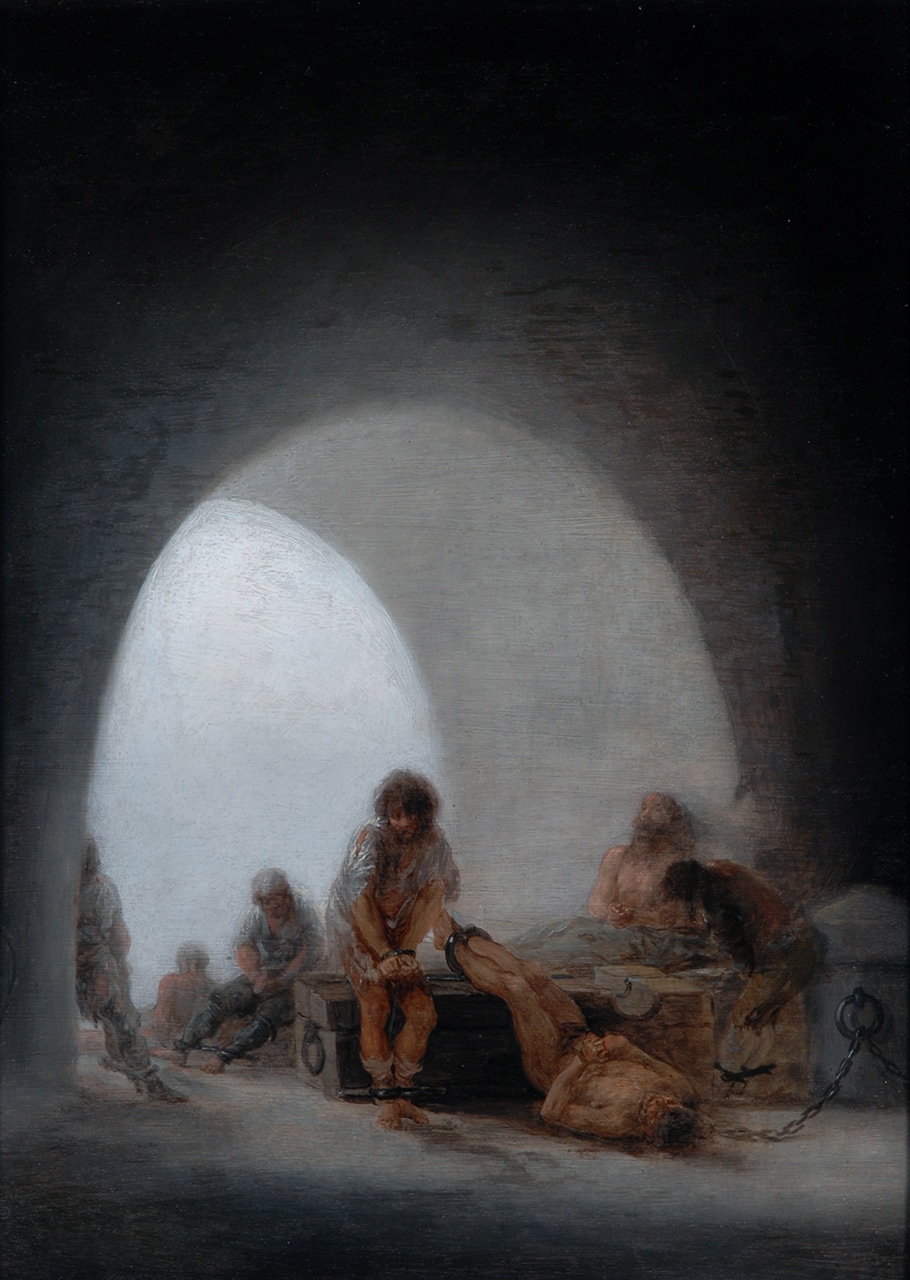
Interior of a Prison
Goya’s Interior of a Prison forms part of a set of twelve small cabinet pictures that he painted on tinplate when convalescing from a serious—and potentially life-threatening—illness in late 1793 or early 1794. Free from the constraints that are traditionally associated with a specific commission, he focused on subjects that reflect his personal interests. These include treatments of bullfighting, depictions of strolling players, and scenes of pain and mortal danger. Amongst these, Yard with Lunatics (1794, Meadows Museum, Dallas), which offers a disturbing vision of life without reason, is the composition most closely related to the one in The Bowes Museum. These themes were innovative in Spanish art and eclipsed the traditional categories of academic painting, which favoured the depiction of subjects from history along with endeavours in portraiture, landscape, and still life.
In this composition, Goya depicts the interior of a prison, focusing on the suffering of seven ragged and unshaven figures whose wrists and ankles are bound by heavy metal chains. Presented in a variety of postures, some of them sit or lean against the prison walls while another lies recumbent in the foreground, his suffering augmented by the sturdy metal chain around his neck—a form of punishment frequently adopted in the prisons of Madrid at the time. With the faces of the prisoners either turned away or lost in shadow, the scene is one of utter desolation. Serving in part as a physical barrier, the thick strong arch under which they are positioned functions simultaneously as a reference to the crushing isolation and ultimate futility of their situation. Cast off from society (and, seemingly, from light itself), the prisoners have been condemned to suffer in a state of dark and ignominious silence—their screams unable to echo beyond the walls in which they have been imprisoned. The only object is a coffin-like wooden box, which serves inevitably as a reference to the slow and lingering death to which they have effectively been sentenced.
Goya’s painting raises issues that are typical of the broader Enlightenment interest in questions of penal reform and the recognition of inalienable human rights—a debate that continues to affect the world in which we live today. The painting asks in particular whether the dehumanizing treatment of prisoners—which seems to close off the possibility of rehabilitation or reintegration—should be considered appropriate in the context of a putatively modern and civilized society.
Goya is the most important and influential Spanish artist of the late eighteenth and early nineteenth centuries, a figure often regarded as the last of the Old Masters and the first of the moderns. He became a court painter to the Spanish Crown in 1786, producing portraits of the Spanish monarchy and aristocracy, but after his 1793–94 illness, which left him deaf, his production became much darker, offering insights into old age, the horrors of war, the nature of mental illness, and the role of the supernatural.
 Click to zoom and pan
Click to zoom and pan
...
Your feedback is very important to us. Would you like to tell us why?
We will never display your feedback on site - this information is used for research purposes.
Artwork Details
Title
Interior of a Prison.
Artist
Francisco José de Goya y Lucientes (Fuendetodos, Aragon, 1746 – Bordeaux, France, 1828).
Date
c. 1793–94.
Medium and Support
Oil on tinplate.
Dimensions
42.9 x 31.7 cm.
Marks and Inscriptions
None.
Acquisition Details
Bequeathed by John and Joséphine Bowes, 1885.
Previous Owners
Léonard Chopinot, Madrid, before 1800; by descent to Angela Sulpice Chopinot, Madrid, before 1805; purchased by John and Joséphine Bowes through Benjamin Gogué, Paris, from the collection of the late Conde de Quinto, 1862.
Institution
The Bowes Museum, Barnard Castle, B.M.69.
Bibliography
Juan Antonio Gaya Nuño, La pintura española fuera de España: historia y catálogo (Madrid: Espasa-Calpe, 1958), p. 169 (no. 999);
Eric Young, Four Centuries of Spanish Painting: 17th June – 17th September 1967, The Bowes Museum, Barnard Castle, County Durham (Gateshead: Team Valley Printers, 1967), p. 64 (no. 85);
Eric Young, Catalogue of Spanish Paintings in the Bowes Museum, 2nd ed. (Middlesborough: The Bowes Museum, 1988), pp. 78–81;
Peter Klein, ‘Insanity and the Sublime: Aesthetics and Theories of Mental Illness in Goya’s Yard with Lunatics and Related Works’, Journal of the Warburg and Courtauld Institutes, 61 (1998): 198–252 (p. 204);
Adrian Jenkins, Goya’s Prison: The Year of Despair (Barnard Castle: The Bowes Museum, 2009);
Véronique Gerard Powell, ‘Spanish Paintings in the Bowes Museum’, in Spanish Art in County Durham, ed. Clare Baron & Andy Beresford (Bishop Auckland: Auckland Castle Trust, The Bowes Museum, & Durham University, 2014), p. 90;
Mercedes Cerón, ‘Interior of a Prison’, https://vads.ac.uk/digital/collection/NIRP/id/27522 [accessed: 11.07.22].
